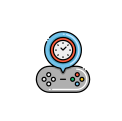

Super Kong World
A person interested in nature, science, sustainability, music, and videogames. I’m also on Mastodon: @glennmagusharvey@scicomm.xyz and @glennmagusharvey@sakurajima.moe
My avatar is a snapping turtle swimming in the water.


Super Kong World


It seems to forget the history beyond a certain date. Like a year or so.
oh yeah i forgot about the Metal Slug games! haven’t played them yet though.


Yeah, N64/PS1 era was when the industry started pushing 3D games hard, and it really feels like the beginning of the modern era to me too.
Wait…is this Felix the Cat??


So that means that programmers are being replaced with debuggers. Human debuggers.
Egads! An error SSL occurred. Secure connect to server be not here.


A keyboard. Any standard computer keyboard.
This post was originally written as a reply to a comment by @redsol2@lemmy.world. But it got kinda long and it’s basically my answer to the thread topic. So yeah, lemme tell y’all a story.
I started out playing 2D platformers for DOS, where the default – or more like, only – control scheme was arrow keys to move and Ctrl and Alt to do things (commonly Ctrl to jump and Alt to shoot). I also grew up on NES, GB, and SNES games, and a handful of PC games. Notably, though, I never picked up FPS games as a child, and also never really got anything from the 32-bit era and beyond until much later in life.
With emulators being more integrated into Windows (meaning Ctrl and Alt do important things), I shifted the action buttons to the lower left corner of the keyboard. Emulating an SNES gamepad, for example, I generally map the action buttons in a mirror-image fashion to ZXCS (respectively, ABYX). (A friend of mine maps them in a similar fashion, using ZXAS instead.) This then lets me map the L and R buttons to A and D respectively. And I move this whole ensemble of six buttons up a row if I have ghosting issues. (The Sega Genesis gamepad can be mapped similarly easily.)
This works brilliantly well (at least for me) for 2D platformers, top-down action games, JRPGs, and more. Notably, though, this excludes pretty much anything that requires analog controls of some sort, e.g. FPS games, N64 games, etc… But between a lack of hardware capable of playing 3D stuff (whether natively or by emulation), a lack of a familiar control scheme, and a lack of personal interest (due to just not having ever gotten into them), I pretty much just stuck with emulating up through the 16-bit era, with a little PS1 emulation thrown in. It’s not like I ever had a shortage of excellent games.
And curiously, it turns out my control scheme (arrow keys + ZXC(V)ASD(F)) is the favored scheme for a number of Japanese indie developers who made things like action games and RPGs using 2D sidescrolling and top-down views. So I ended up having even more to play! In contrast, it seems western devs often prefer WASD, even for stuff like 2D platformer Flash games (to my chagrin). And I see (English-speaking) PC gamers these days regarding my sort of control scheme as a “left-handed” setup (which is amusing since I’m not left-handed).
I only learned to WASD as an adult. At first I even tried to use the mouse with my left hand, and tried putting my left hand on the arrow keys, but eventually I gave in and learned to WASD. I still only use this when I need to use mouse aim though, e.g. Terraria (which I played a lot).
For games that actually require console-style analog controls, though, I nowadays have a wired XB360 gamepad that connects via USB. I’ve tried mapping things like the N64 gamepad to a keyboard before but with no success. But now that I have this, funny thing is this means I’m only recently getting into a number of classics from that era.
I’ve considered getting an 8BitDo SN30 or SN30 Pro(?)…whichever basically looks like an SNES pad with added analog sticks. I specifically want a gamepad without “legs” – the two stubs that seem to be meant as palm grips on each side of the gamepad. That’s because I held my SNES pad from the side so that I could press A, B, and Y at the same time with my right thumb. (This was highly useful when playing Mega Man X.) Controllers with “legs” basically make it way harder for me to do this, as I found out when I tried to play MMX4 on my PS1. It felt so awkward, I just went straight back to emulating it, despite having the disc and hardware.
But, for now, I only pull out my XB360 gamepad for stuff that needs analog stick functionality. Everything else is keyboard. (And mouse, if needed.)


This picture is possibly banned by the church, and I love it.


I wish someone had shown me the ropes to get into WRPGs (and other genres that I have yet to really familiarize myself with) back in the day.
There’s a lot of really neat stuff in the genre that seems hard to get into without taking the time to learn how to make the most of it. Maybe it’s that I’m now an adult and I know a bit too much, but I’ve had problems like sitting down with Neverwinter Nights 2 and then realizing that I should go research character builds before I start playing the game. And then, of course, that just means I forget about playing the game for another year or two.
And this isn’t even anywhere near the most obtuse game to learn. There are very complex games (particularly some sim games) that really seem like they’d be great fun if only I actually knew how to play them, but I don’t.


My friend lent me his copy of FF7 PC, and I tried playing it – albeit after I played earlier FF games.
There were two problems. First, it was…kinda weird compared to earlier games. Sure, the steampunk vibes began in FF6, but we didn’t have Literally An Evil Megacorp and Literally Eco-Terrorists fighting over Something That Feels A Lot Like An Analogy For Nuclear Power. That was a whole nother level. Nothing wrong with this per se, but it just felt like something quite different. Neat, but just not the same FF I was used to.
But, perhaps more importantly, the game just kept crashing. I kept going as far as I could, but the game just wouldn’t progress past the introduction to the Gold Saucer.


The first time played Super Metroid, it was after I played Fusion and Zero Mission, and I was actually rather unimpressed by it, despite it being basically a platinum standard for 2D metroidvanias.
It was only later, after playing various romhacks including randomizers and getting much more accustomed to the game engine and the sheer number of possibilities afforded by various speed tricks and sequence-breaking techniques, that I gradually realized why it’s held in such high regard. The game is…neat, if you simply play through it once. But the more you learn about it the more you can do with it and the more fascinating it becomes. There is a seemingly infinite depth to it, which is not at all obvious on a first playthrough. In fact, some of it appears to be accidental, possibly game design bugs on the programmers’ part, yet somehow such imperfects have made it even more of a masterpiece.


I think there’s something to be said that there’s a certain level of intellectual maturity that’s needed to truly enjoy these games.
I grew up with NES Metroid, and despite having read the manual many times over, as a kid I never made sense of the game. I could play it, I could insert the Justin Bailey code, I could move around and do stuff, but I never truly understood what I was meant to do. I stumbled into Tourian one day and promptly got pwned by metroids, and then I never found my way back until I was an adult.
The second metroidvania game I played was Castlevania: Harmony of Dissonance. Maybe it’s an easier game – it’s certainly less confusingly open-ended than Metroid 1 – but I absolutely loved the experience. I deeply appreciated the narrative journey of being trapped in this castle, full of weirdness and twisty passages that were slightly off from each other, having the mid-game bombshell dropped on me, and piecing together a mystery until I was able to find out what was going on. I played it all night, and in a story I like to tell people, the morning after I beat it (and finally got the best ending), as the sun came out, I put on the Aloha de Chocobo music from Final Fantasy IX and it was the most glorious feeling. But this depended on me understanding that I was immersed in a maze, and understanding what I needed to do to find my way out of the maze.
And I’ve been enjoying this genre since.
For whatever reason, I’m scratching my brain and can only come up with three urban fantasy games plus a franchise I’m not too personally familiar with. The three games are Underrail (an indie game from some years back, which I bought back when it wasn’t even fully released yet, but still have yet to play), Operation Abyss (a dungeon crawler with modern-ish graphics but gameplay that definitely takes after old Wizardry games; the theming leans somewhat more on the science-fantasy side), and Tokyo Xanadu eX+ (an action JRPG that’s something of a cross between Trails of Cold Steel and modern Ys games). The franchise is the Persona series, none of which I’ve played, and which Tokyo Xanadu gets compared to despite not being all that similar under the hood.
I don’t think any of these are what you’re looking for, but I hope they may help you on your search.


Oh, I actually meant “real” saves, done from in-game. It’s like Lemuroid had some chance of not updating the save file. I never figured out why this might happen. (Maybe it has something to do with not properly generating a new state on exit and having old states wipe newer saves?)


I’ve used Lemuroid for Game Boy emulation before but it had trouble remembering my saves for some reason. It’d sometimes forget that I’d saved recently, and so I’d load and find myself in an earlier save. Also on a Samsung phone, albeit an A-series. Do you know what might have caused this?


I wasn’t part of the original but I subscribed anyway. Thanks for creating the community!


Yeah, 100% OJ is…interesting.
Though I’d say if you’re beating 25% wins or so you’re already doing above par. (Par may be slightly above that since CPU players tend to be stupid, though they may have improved the AI since I last played.)


I recently noticed that 100% Orange Juice is actually getting a competitive scene, it seems.
It’s a 4-player virtual board game where there’s strategy involved in deck construction (one funny thing is that anyone can draw your cards so you have to choose carefully based on your choice of character and their special abilities), movement choices, understanding probabilities and other tactical decisions, and balancing risk/reward under uncertainty.
I used to be huge into the game but I haven’t been following it for the past couple years or so.
The way Mario seems to teleport when turning around in the water seems to say something about the way hitboxes worked in the original DKC1.